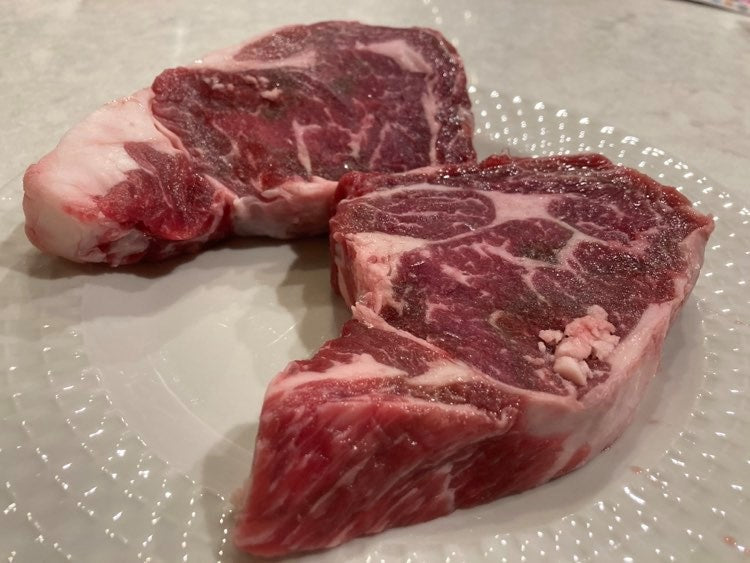
The Surging Cost of Beef: What It Means for Consumers and Farmers
Share
Have you noticed that the price of beef has skyrocketed in recent years? Understanding the factors contributing to this increase is more important than ever, especially for consumers looking to make informed purchasing choices. Let's dig into
the factors that have caused beef prices to rise and explore how we are contributing to a humane and sustainable meat supply. From economic shifts to environmental challenges, let's discuss ways to keep your kitchen stocked without breaking the bank.
1. Economic Factors Influencing Beef Prices
Supply Chain Disruptions
The COVID-19 pandemic dramatically disrupted supply chains worldwide,
including that of beef. Processing plants faced shutdowns or limited capacities
due to health regulations, leading to significant shortages in the market. As
demand remained high but supply dwindled, prices increased. Consumers saw the
impact immediately at the grocery store.
Feed and Cattle Costs
Animal feed constitutes a significant portion of the total cost of raising cattle. In
recent years, grain prices have experienced volatility due to various factors:
weather, trade tensions affecting exports, and shifts in biofuel demand. It is also more costly to purchase cattle as the national cattle inventory continues to decrease.
Consumer Demand Trends
Consumers are becoming increasingly conscious of where their food comes from
and how it is produced. This uptick in demand for locally sourced and humanely
raised meat has driven some farms, like ours, to adopt more sustainable
practices. However, the gap between consumer demand and production
creates further strains on the economy, influencing overall pricing.

2. Environmental Impact and Sustainability Practices
Today’s consumers are more environmentally conscious. Sustainable farming
practices can contribute to higher production costs, as they often require more
labor and resources. Regenerative agriculture, which focuses on rebuilding soil
health and biodiversity, may initially seem costlier but can lead to a more
sustainable system long-term. As awareness of these practices grows, consumers
are willing to pay a premium for meat that is better for the planet.
3. The Role of Locally Sourced Beef
Supporting Local Farms
Local farms offer a solution to some of the challenges the beef industry faces. By
supporting local and humane operations, consumers can help decrease the
demand for mass-produced beef and encourage more environmentally friendly
and ethical practices. We are committed to providing ethically raised beef, pork, chicken, and eggs while supporting the local economy. This shift not only helps reduce the carbon footprint associated with transporting meat across long distances but also ensures that the meat sold is fresher and of higher quality.
Benefits of Ordering Bulk Beef
Ordering in bulk from local farms can also be a cost-effective solution for your family.
While the initial expense might seem daunting, buying in bulk can lead to
significant savings over time. Consumers can purchase directly from local farms, eliminating the middleman and reconnecting them to the source of their food.

4. Navigating Price Increases
Budgeting for Increased Beef Prices
As prices continue to fluctuate, effective budgeting becomes essential. Here are
some strategies that can help consumers manage and offset these rising costs:
- Plan Meals: Create weekly menus that utilize what you have and incorporate
sales or seasonal produce. - Buy in Bulk: Ordering larger quantities, splitting with friends or
family, or participating in a community-supported agriculture (CSA) model can
lessen costs. - Explore Alternatives: Consider diversifying your meat selections or
incorporating a variety of proteins in your diet to help cut down on costs. Making a batch of taco meat with a pound of ground beef and a pound of ground pork can make your dollar stretch farther.
Accessing Resources for Local Beef
Consumers can learn how to access resources such as local farmer’s markets, community-supported agriculture programs, and organizations that connect consumers with local farms. These resources can help find affordable, humanely raised beef while minimizing expenses.
5. Looking Toward the Future
The Evolving Beef Industry
As we move forward, the beef industry must adapt to increasing consumer demands for sustainability, welfare, and health. Many local farmers have these requests and are developing better farming practices and educate consumers on their local farming practices.
Final Thoughts on Beef Pricing Trends
In a world where prices for essential foods like beef are rising, understanding the various factors at play can help consumers make better choices. By supporting local suppliers who prioritize humane and sustainable practices, you can enjoy high-quality meat while also contributing positively to the community and the environment. As a consumer, you have the power to influence change in the industry, and every purchase decision can have a far-reaching impact.
So, What Now?
As prices continue to rise and consumers seek solutions, consider taking a step toward supporting local farms. By ordering bulk beef directly from local producers, you can not only save money in the long run but also contribute to a sustainable food future.
Remember, your purchasing decisions matter. Together, we can foster an agricultural landscape that is ethical, sustainable, and aligned with our values. Quality meat is not merely a transaction; it’s a commitment to support practices that benefit our health as well as that of the planet.

